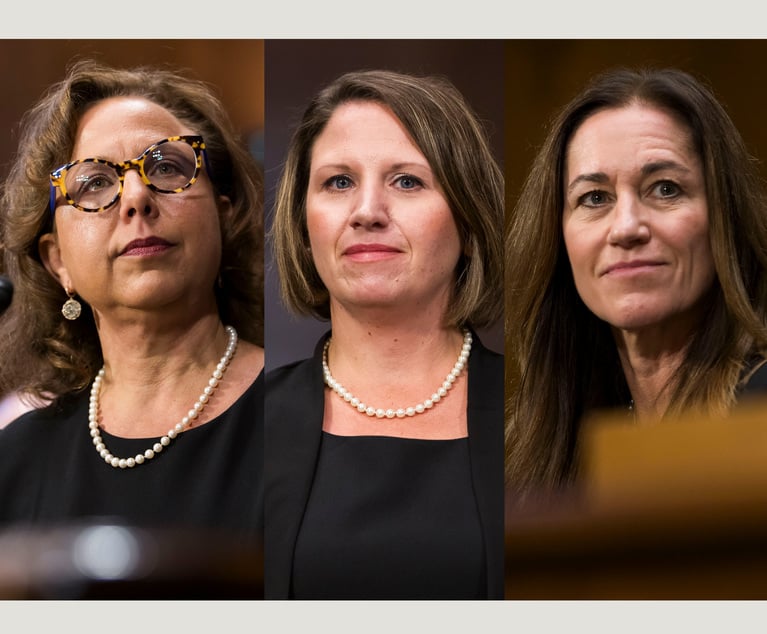Counting on Change: Looming Updates to EB-5 Visa Program and More
On June 27, the Office of Management and Budget (OMB) announced that it concluded its review of the EB-5 Immigrant Investor Program Modernization rule.
July 16, 2019 at 01:26 PM
6 minute read
 Jessica A. DeNisi, Klasko Immigration Law Partners
Jessica A. DeNisi, Klasko Immigration Law Partners
On June 27, the Office of Management and Budget (OMB) announced that it concluded its review of the EB-5 Immigrant Investor Program Modernization rule. The completion of OMB review and release of the regulation is, based on the regulation map provided on the government's website, step eight in the nine-step process to publication and enactment of a final rule. As such, publication of the final rule seems imminent. Nonetheless, today we are still uncertain of the future of the EB-5 Immigrant Investor Program Modernization rule. We do not know when the regulation will be published, if it will provide the normal grace period before becoming effective, or, more importantly, what changes the final rule will bring to the EB-5 program. Presumably, the final rule will largely resemble the draft regulations released in January, over two years ago.
In mid-January 2017, the Department of Homeland Security (DHS) published a notice of proposed rulemaking (NPRM) for the EB-5 program. Most prominently, in the NPRM, DHS proposed to increase the minimum investment amounts for all new EB-5 petitioners. Specifically, DHS proposed that the standard minimum investment amount should be increased from the current amount of $1 million to $1.8 million to adjust for inflation. At the same time, DHS proposed to increase the investment amount for those investors seeking to invest and file I-526 petitions in a new commercial enterprise that principally will be doing business in a targeted employment area (TEA), from $500,000 to $1.35 million. The proposed rules would also have provided for DHS to make future adjustments to the investment amount based on the Consumer Price Index for urban consumers every five years.
DHS also proposed to reform the TEA designation process, which was proposed to include, among other initiatives, to eliminate the ability of a state to designate geographic and political subdivisions as areas of high-unemployment that would qualify for TEA status. DHS proposed that it would instead make such designations, using the procedure and standards set forth in the proposed rule. Finally, the proposed rule would have allowed certain EB-5 petitioners to retain their priority dates on approved I-526 petitions for use as needed with subsequent EB-5 petitions.
Not surprisingly, many believe the increased investment amount and more restrictive TEA definition will have a chilling effect on the EB-5 program; resulting in a significant reduction in foreign investors' appetite for participation in the EB-5 program. However, many also believe that an increase in the investment is reasonable as the amount has not increased since the initiation of the program decades ago. While the almost certain increase in the investment amount will impact the program, the biggest obstacle to the continued popularity or viability of the EB-5 programs remains the backlog for visas for immigrants from certain countries as a result of the annual per-country cap on visas in certain categories. Most notably, investors from China starting the EB-5 process today could wait 15 years in order to obtain a conditional green card. Investors from India and Vietnam also face a multi-year wait, though shorter than China for now, with other countries anticipated to join the backlog in the coming years. Excessive visa wait times also exist for nationals of certain countries, notably India and China, in the other employment-based visa categories. This, coupled with current USCIS processing times, now posted at 25 to 45 months for an I-526 petition and 28 to 43.5 months for an I-829 petition, will likely have a more profound effect on the program's viability than an increase in the investment amount.
Meanwhile, on July 11, Sen. Rand Paul introduced the Backlog Elimination, Legal Immigration, and Employment Visa Enhancement Act (the BELIEVE Act), S.2091, which would, among other things, abolish the annual per-country limit on employment-based visas, increase the number of employment-based green cards available for qualified immigrants each year, exempt certain dependents (spouses and children) from counting against the limitation on the number of employment-based visas each year, and allow dependents of certain visa holders to apply for employment authorization. The increase in the number of available visas each year would apply to employment-based visas in the first through third preference categories and the EB-5 visa category (the fifth preference category). In addition, exempting minor children and spouses from counting against the numerical visa limitation each year would have a profound effect on the current visa backlog, as over half of the employment-based visas are currently allocated to spouses and children who do not necessarily work. The introduction of the BELIEVE Act comes just days after the House of Representatives passed the Fairness for High-Skilled Immigrants Act (H.R. 1044). HR 1044 would also eliminate per-country caps and increase the number of family-based immigrants. A similar bill was also introduced in the Senate, with certain modifications.
The notion of increasing the number of visas available every year would help the would-be immigrant population at large. Eliminating per country caps would substantially benefit investors from countries such as India and China, which face the longest wait times for most employment-based visa categories, including EB-5. At the same time, an individual born in India currently faces a wait for an EB-2 visa (available for persons with advanced degrees) of decades, with some predicting a current wait time of over 100 years.
The House and Senate versions of the Fairness for High-Skilled Immigrants Act or the BELIEVE Act would be a boon for an investor from India or China with an older priority date (or certain other employment-based categories) with older priority dates. However, any bill that would eliminate country caps would negatively impact EB-5 investors and others seeking employment-based visas from every other country, whose average wait time would increase by a number of years. A solution that would benefit all foreign nationals would have to include an increase in the number of employment visas world-wide as well as provide for the exemption of dependents from inclusion in the yearly limitation on visa numbers.
Jessica A. DeNisi is an associate in the Klasko Immigration Law Partners' Philadelphia office and a member of the EB-5 practice. She works with developers and investors who seek to use foreign investment capital under the EB-5 program to fund job-creating projects.
This content has been archived. It is available through our partners, LexisNexis® and Bloomberg Law.
To view this content, please continue to their sites.
Not a Lexis Subscriber?
Subscribe Now
Not a Bloomberg Law Subscriber?
Subscribe Now
NOT FOR REPRINT
© 2025 ALM Global, LLC, All Rights Reserved. Request academic re-use from www.copyright.com. All other uses, submit a request to [email protected]. For more information visit Asset & Logo Licensing.
You Might Like
View All
Pa. Federal District Courts Reach Full Complement Following Latest Confirmation

The Defense Bar Is Feeling the Strain: Busy Med Mal Trial Schedules Might Be Phila.'s 'New Normal'
7 minute read
Federal Judge Allows Elderly Woman's Consumer Protection Suit to Proceed Against Citizens Bank
5 minute read
Judge Leaves Statute of Limitations Question in Injury Crash Suit for a Jury
4 minute readTrending Stories
- 1Thursday Newspaper
- 2Public Notices/Calendars
- 3Judicial Ethics Opinion 24-117
- 4Rejuvenation of a Sharp Employer Non-Compete Tool: Delaware Supreme Court Reinvigorates the Employee Choice Doctrine
- 5Mastering Litigation in New York’s Commercial Division Part V, Leave It to the Experts: Expert Discovery in the New York Commercial Division
Who Got The Work
J. Brugh Lower of Gibbons has entered an appearance for industrial equipment supplier Devco Corporation in a pending trademark infringement lawsuit. The suit, accusing the defendant of selling knock-off Graco products, was filed Dec. 18 in New Jersey District Court by Rivkin Radler on behalf of Graco Inc. and Graco Minnesota. The case, assigned to U.S. District Judge Zahid N. Quraishi, is 3:24-cv-11294, Graco Inc. et al v. Devco Corporation.
Who Got The Work
Rebecca Maller-Stein and Kent A. Yalowitz of Arnold & Porter Kaye Scholer have entered their appearances for Hanaco Venture Capital and its executives, Lior Prosor and David Frankel, in a pending securities lawsuit. The action, filed on Dec. 24 in New York Southern District Court by Zell, Aron & Co. on behalf of Goldeneye Advisors, accuses the defendants of negligently and fraudulently managing the plaintiff's $1 million investment. The case, assigned to U.S. District Judge Vernon S. Broderick, is 1:24-cv-09918, Goldeneye Advisors, LLC v. Hanaco Venture Capital, Ltd. et al.
Who Got The Work
Attorneys from A&O Shearman has stepped in as defense counsel for Toronto-Dominion Bank and other defendants in a pending securities class action. The suit, filed Dec. 11 in New York Southern District Court by Bleichmar Fonti & Auld, accuses the defendants of concealing the bank's 'pervasive' deficiencies in regards to its compliance with the Bank Secrecy Act and the quality of its anti-money laundering controls. The case, assigned to U.S. District Judge Arun Subramanian, is 1:24-cv-09445, Gonzalez v. The Toronto-Dominion Bank et al.
Who Got The Work
Crown Castle International, a Pennsylvania company providing shared communications infrastructure, has turned to Luke D. Wolf of Gordon Rees Scully Mansukhani to fend off a pending breach-of-contract lawsuit. The court action, filed Nov. 25 in Michigan Eastern District Court by Hooper Hathaway PC on behalf of The Town Residences LLC, accuses Crown Castle of failing to transfer approximately $30,000 in utility payments from T-Mobile in breach of a roof-top lease and assignment agreement. The case, assigned to U.S. District Judge Susan K. Declercq, is 2:24-cv-13131, The Town Residences LLC v. T-Mobile US, Inc. et al.
Who Got The Work
Wilfred P. Coronato and Daniel M. Schwartz of McCarter & English have stepped in as defense counsel to Electrolux Home Products Inc. in a pending product liability lawsuit. The court action, filed Nov. 26 in New York Eastern District Court by Poulos Lopiccolo PC and Nagel Rice LLP on behalf of David Stern, alleges that the defendant's refrigerators’ drawers and shelving repeatedly break and fall apart within months after purchase. The case, assigned to U.S. District Judge Joan M. Azrack, is 2:24-cv-08204, Stern v. Electrolux Home Products, Inc.
Featured Firms
Law Offices of Gary Martin Hays & Associates, P.C.
(470) 294-1674
Law Offices of Mark E. Salomone
(857) 444-6468
Smith & Hassler
(713) 739-1250





